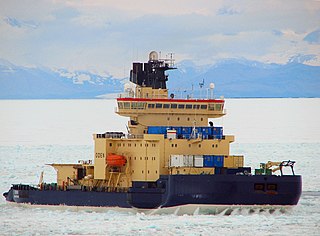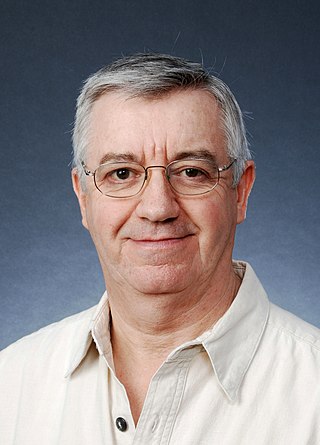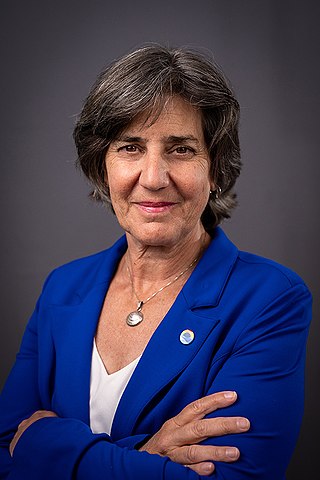Related Research Articles

The Canadian Coast Guard is the coast guard of Canada. Formed in 1962, the coast guard is tasked with marine search and rescue (SAR), communication, navigation, and transportation issues in Canadian waters, such as navigation aids and icebreaking, marine pollution response, and support for other Canadian government initiatives. The Coast Guard operates 119 vessels of varying sizes and 23 helicopters, along with a variety of smaller craft. The CCG is headquartered in Ottawa, Ontario, and is a special operating agency within Fisheries and Oceans Canada.
Fisheries and Oceans Canada is a department of the Government of Canada that is responsible for developing and implementing policies and programs in support of Canada's economic, ecological and scientific interests in oceans and inland waters. Its mandate includes responsibility for the conservation and sustainable use of Canada's fisheries resources while continuing to provide safe, effective and environmentally sound marine services that are responsive to the needs of Canadians in a global economy.

Oden is a large Swedish icebreaker, built in 1988 for the Swedish Maritime Administration. It is named after the Norse god Odin. First built to clear a passage through the ice of the Gulf of Bothnia for cargo ships, it was later modified to serve as a research vessel. Equipped with its own helicopter and manned by 15 crew members it has ample capacity to carry laboratory equipment and 80 passengers, functioning independently in harsh Polar ice packs of the Arctic and Antarctic seas. It was the first non-nuclear surface vessel to reach the North Pole, together with the German research icebreaker Polarstern. It has participated in several scientific expeditions in Arctic and Antarctica.

CCGS Louis S. St-Laurent is a Canadian Coast Guard (CCG) heavy icebreaker. Louis S. St-Laurent's home port is St. John's, Newfoundland and Labrador. She is the largest icebreaker and flagship of the CCG.
Keith Thompson was a professor at Dalhousie University with a joint appointment in the Department of Oceanography and the Department of Mathematics and Statistics.

CCGS John P. Tully is an offshore oceanographic science vessel in the Canadian Coast Guard operating out of Pacific Region at CGS Base Patricia Bay in Sidney, British Columbia. Prior to 1995, the ship was assigned to Fisheries and Oceans Canada. The vessel entered service in June 1985 with the Department of Fisheries and Oceans on the West Coast of Canada. In 1995, the fleets of Fisheries and Oceans and the Canadian Coast Guard were merged under Canadian Coast Guard command and John P. Tully became a Coast Guard vessel.

The Arctic Ocean is the smallest and shallowest of the world's five oceanic divisions. It spans an area of approximately 14,060,000 km2 (5,430,000 sq mi) and is known as one of the coldest of oceans. The International Hydrographic Organization (IHO) recognizes it as an ocean, although some oceanographers call it the Arctic Mediterranean Sea. It has also been described as an estuary of the Atlantic Ocean. It is also seen as the northernmost part of the all-encompassing world ocean.
Fiona McLaughlin is a senior Oceanographer, employed by Canada's Department of Fisheries and Oceans. McLaughlin joined government service in 1972. Since 1994 she has concentrated on the ecology of the Arctic Ocean.
St. Andrews Biological Station is a Fisheries and Oceans Canada research centre located on Brandy Cove Road in St. Andrews, New Brunswick.
The National Shipbuilding Strategy (NSS), formerly the National Shipbuilding Procurement Strategy (NSPS), is a Government of Canada program operated by the Department of Public Works and Government Services. The NSS was developed under the Stephen Harper Government in an effort to renew the fleets of the Royal Canadian Navy (RCN) and the Canadian Coast Guard (CCG). The strategy was broken into three sections; the combat package, the non-combat package and the smaller vessel package. The companies who won the bids for the larger ships were not permitted to bid on the smaller vessel package. In 2019 the Trudeau Government decided to add a third shipyard to the NSS specializing in the construction of icebreakers for the Coast Guard. The agreement to incorporate Davie as a third shipyard within the NSS was finally signed in April 2023.
William Li is a Canadian biological oceanographer who did research on marine picoplankton, marine macroecology, ocean surveys of plankton from measurements of flow cytometry, and detection of multi-annual ecological change in marine phytoplankton.

Trevor Charles Platt was a British and Canadian biological oceanographer who was distinguished for his fundamental contributions to quantifying primary production by phytoplankton at various scales of space and time in the ocean.

Tuvaijuittuq Marine Protected Area is a marine protected area located off the northwest coast of Ellesmere Island in Nunavut, Canada. The goal of the marine protected area is to protect the rich biodiversity and dynamism of the High Arctic sea ice ecosystem. Covering an area of 319,411 square kilometres (123,325 sq mi), Tuvaijuittuq is the largest protected area in Canada and among the largest protected areas in the world. It is part of a large oceanic region referred to as the Last Ice Area, located adjacent to the coasts of northern Greenland and the Canadian Arctic Archipelago, which contain and accumulate the oldest remaining sea ice in the Arctic.
The British Columbia Shore Station Oceanographic Program is a sea surface temperature and salinity monitoring program on the Canadian coast of the northeast Pacific Ocean. The program is administered by Fisheries and Oceans Canada, and regroups 12 lighthouse stations in British Columbia. Most lighthouses are staffed by the Department of Fisheries and Oceans, but some have independent contractors instead.
Ann Gargett is a Canadian oceanographer known for her research on measuring turbulence and its impact on biological processes in marine ecosystems.
Jacqueline M. Grebmeier is an American ecologist who specializes in polar biological oceanography.

Dr. Anya Waite is a Canadian biological oceanographer working at the Ocean Frontier Institute at Dalhousie University.

The Last Ice Area is broadly the large interior polar region of the Arctic Circle covering an area between the northern edge of Greenland and the Canadian Arctic Archipelago and is the most northerly coastal zone of the world. Being in a permafrost landscape, it is the oldest and thickest ice sheet in the Arctic and is expected to persist longest as a sea ice. Towards the northern side, it consists of the Tuvaijuittuq Marine Protected Area, which is the largest protected area in Canada and among the largest protected areas in the world. It is one of the major centres of environmental concerns that is bound to have global impact. The Arctic Council's 2017 report Snow, Water, Ice and Permafrost. Summary for Policy-makers predicted that current rate of climate change will cause the complete disappearance of the ice within a century.

Tarium Niryutait is a marine protected area (MPA) located in the coastal areas of the Yukon and Northwest Territories in Canada. It is located within the Inuvialuit Settlement Region and was the first Arctic MPA established in Canada. The MPA was established with the goal of protecting Beluga whales and the biodiversity of other bird and fish species and their habitats.
References
- ↑ Dickie, Gloria (February 2, 2018). "Famed Polar Scientist: Arctic Ocean Research at a Turning Point". newsdeeply.com. Retrieved March 12, 2020.
- 1 2 Watts, Richard (January 13, 2018). "Oceanographer's polar fascination spans almost 50 years of research". Times Colonist. Retrieved March 12, 2020.
- ↑ Wong, Hugo (January 20, 2018). "Peninsula scientist lauded for Arctic research". Peninsula News Review. Retrieved March 12, 2020.
- ↑ "EDDY CARMACK CHAPMAN CHAIR 2006-2015". cnsm.uaf.edu. Retrieved March 12, 2020.
- ↑ "Key Findings from International Polar Year 2007-2008 at Fisheries and Oceans Canada: Executive Summary". dfo-mpo.gc.ca. Retrieved March 12, 2020.
- ↑ Singer, Michelle (August 15, 2007). "Ocean Currents & Climate Change". cbsnews.com. Retrieved March 12, 2020.
- ↑ "Massey Medal". rcgs.org. 2007. Retrieved March 12, 2020.
- ↑ "Dr. Eddy Carmack - J.P. Tully Medal in Oceanography". dfo-mpo.gc.ca. March 31, 2010. Retrieved March 12, 2020.
- ↑ Holling, Buzz (April 5, 2011). "RESILIENCE AND LIFE IN THE ARCTIC". rs.resalliance.org. Retrieved March 12, 2020.
- ↑ Wilson, Carla (December 27, 2019). "Arctic oceanographer from Saanichton among Order of Canada honourees". Times Colonist. Retrieved March 12, 2020.
- ↑ Tanya Clayton. "RENOWNED MATHEMATICAL PHYSICIST TO ACCEPT SYDNEY CHAIR". cnsm.uaf.edu. Retrieved March 12, 2020.
- ↑ "B.C. man wins inaugural Mohn prize for Arctic research". cbc.ca. January 18, 2018. Retrieved March 12, 2020.
- ↑ "Eddy Carmack receives the Order of Canada". pipsc.ca. Retrieved March 12, 2020.